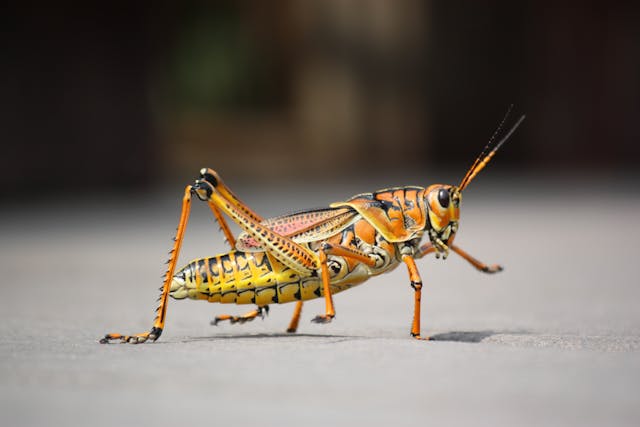
Why can grasshoppers jump so high? They can store energy in their exoskeleton and release it like a spring.
Grasshoppers are not all the same. They are a small group of insects in the Caelifera family, which contains about 12,000 species. Locusts are grasshoppers and they belong to this family, and many other insects that can hop. About 11,000 of the species in the Caelifera family are grasshoppers and there is a huge variety. The smallest grasshoppers are the pygmy grasshoppers, which are about 20 mm long. The largest grasshoppers are the giant red-winged grasshoppers, which can grow up to 24 cm long. Grasshoppers, and their more voracious cousins the locust, are generally considered to be a pest. Locusts fly in swarms of billions and can strip fields of crops in minutes. One of the ten plagues of Egypt was locusts, and that is not uncommon. They fly with the wind and eat everything living in their path. In 1954, a desert locust swarm in Kenya consumed over 200 square kilometers of plants.
The height and distance grasshoppers jump depends on their size, but they can generally jump twenty times their body length. If we could do that, most of us could jump over 35 meters, but the landing would probably kill us. Grasshoppers have evolved the ability to jump so high to get away from predators. They also use it to launch themselves into the air so they can fly. Flying uses a lot more energy than jumping does and insects always need to conserve energy. If they launch themselves off the ground and open their wings, the wind will carry them away. Grasshoppers and locusts always fly with the wind because it saves them energy. It is also a method of finding food because wind is air moving from high pressure to low pressure and the rain goes the same way. If they follow the wind, they are likely to find growing crops.
So, how do grasshoppers jump so high? It comes down to two things. They need to be able to store a lot of force and they need to be able to release all of that force against something. The jump force comes from the back legs of the grasshopper, which are much larger then the two front sets of legs. The leg has three parts. The top part is the largest and it is called the femur. The lower part is thinner, and it is called the tibia. The bottom part is the foot. The foot and the tibia have small spikes on them. The spikes on the foot are so that the grasshopper can grip the surface it is jumping off and apply maximum jump force without slipping. The spikes on the tibia are defensive. Grasshoppers can also use their impressive leg strength to kick out at an enemy. They change the angle and use their legs as weapons. If you manage to pick up a grasshopper and feel a nip, that is probably the grasshopper kicking you. It won’t do any damage, but it might surprise you enough to drop it, which is the main purpose.
Grasshoppers have two muscles in the femur part of the legs. The extensor muscle is the one that provides the jump force, and the flexor muscles is the one that holds the force before it is released. The extensor muscle is much bigger and fills most of the femur, while the flexor muscle is just a thin muscle at the bottom. The muscles are attached to the tibia by tendons. When the grasshopper jumps, signals are sent by its nervous system to the flexor muscle, which pulls the tibia in, so it is touching the femur. There is a structure on the knee of the leg which slips into a pocket and holds the flexed leg in place. Once the leg is flexed, the much bigger and much stronger extensor muscle contracts. Muscles can’t contract and release very quickly, and if the grasshopper only had muscles to rely on, it couldn’t jump very high. When the extensor muscle contracts, it bends a hard section of the exoskeleton in the knee. This section is very stiff and it can store a lot of energy without bending very far. This is the part of the leg that can catapult the grasshopper because it can release a lot of energy very quickly. When the grasshopper is ready to jump and all of the energy is stored in the exoskeleton, and some in the tendons, the flexor muscle relaxes, it releases the lump, the stored energy flips the tibia back, the claws in the foot grip the surface, and the tremendous force is pushed down, catapulting the grasshopper up. The whole process takes about half a second. And that is what I learned today.
Photo by Pixabay: https://www.pexels.com/photo/macro-photography-of-orange-grass-hopper-59981/
Sources
https://www.st-andrews.ac.uk/~wjh/jumping/index.html
https://en.wikipedia.org/wiki/Tetrigidae
https://en.wikipedia.org/wiki/Tropidacris_cristata
https://www.nature.com/articles/d41586-020-02453-8

Pingback: Why can animals jump higher and farther than us?